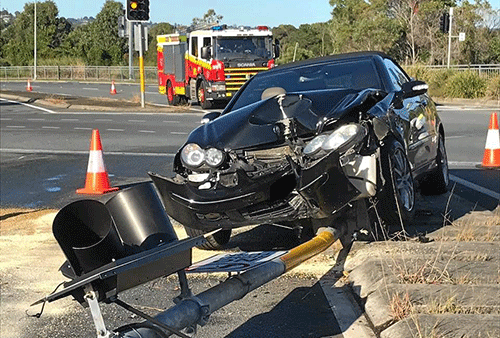Community Policing Officer
Traffic signals are designed to ensure an orderly flow of traffic in the capital in order to provide an opportunity for pedestrians or vehicles to cross an intersection and help reduce conflicts between vehicles entering intersections from different directions. However, almost if not every week the spate of damage to traffic lights through crashes associated with speeding, reckless driving, drunk driving and those driving without valid driver’s licenses is alarming.
The City of Windhoek spends about N$34 500 to erect a standard traffic light pole, while an overhead pole costs about N$47 500. Statistically, Otjomuise, Wanaheda and Khomasdal are amongst the many areas in the city with traffic lights frequently crashed into. Offenders of this transgression have a tendency of fleeing the scene of the accidents before police officers arrive. They do this with the intention of escaping accountability. Meanwhile, a damaged traffic light results in numerous inconveniences such as that the traffic lights switch off or start to malfunction resulting in inconvenient traffic congestion and an increased risk of accidents.
The Windhoek City Police Service therefore cautions that, a driver of a vehicle who is involved in any accident where there is damages in respect of any property, including a traffic signal, should first ascertain the nature and extent of any damage sustained as stipulated in section 78 of Road Traffic and Transport Act, 1999 (Act 22 of 1999).
In the same vein, the Act stipulates that any vehicle involved in an accident in which there is damage to property should shall not be removed; by any person from the position in which it came to rest, except if such removal is authorised by a traffic officer.
Consequently, if damage to the traffic signal causes a complete obstruction of the roadway at an intersection, such vehicle may without such authorisation be moved sufficiently to allow the passage of traffic, providing the person moving the vehicle ensures the stationary position thereof is first clearly marked on the surface of the roadway before it is moved. Therefore, in any prosecution for an offence under this regulation, it shall be presumed, in the absence of evidence to the contrary, that the accused was aware of the fact that the he or she bumped the traffic lights and an accident had occurred, and that he or she did not report the accident or furnish the information as required.
When a driver fails to ascertain the nature and extent of any damages caused during a crash or in other words, when such driver flees from the scene of accident, it amounts to a No Admission Of Guilt (NAOG) offence which means upon sight by a police officer the driver will be arrested.
The benefits of traffic lights must therefore be duly noted as they contribute to; providing orderly movement of traffic; increasing traffic-handling capacity of an intersection; reducing frequency and severity of certain types of crashes; providing for continuous movement of traffic at a definite speed along a given route; as well as to helping interrupt heavy traffic at intervals to permit other vehicles or pedestrians to cross.
It is on that basis that the Windhoek City Police Service urges all road users to be the eyes and ears of law enforcement by providing information for the positive identification of the culprits and to take care of road infrastructure and in unfortunate eventualities to report incidences of damage in order to ensure the safety of all road users.
Help the Windhoek City Police Service in its commitment to making Windhoek the safest city in Africa.
Contact the Windhoek City Police Service on 061 302 302 or 061 290 2239 and SMS on 4444 for any road safety related emergencies, crime and bylaws related issues.


